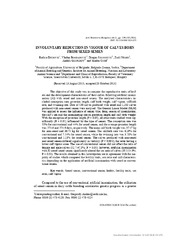Приказ основних података о документу
Involuntary reduction in vigour of calves born from sexed semen
| dc.creator | Djedović, Radica | |
| dc.creator | Bogdanović, Vladan | |
| dc.creator | Stanojević, Dragan | |
| dc.creator | Nemes, Zsolt | |
| dc.creator | Gaspardy, Andras | |
| dc.creator | Cseh, Sandor | |
| dc.date.accessioned | 2020-12-17T21:35:09Z | |
| dc.date.available | 2020-12-17T21:35:09Z | |
| dc.date.issued | 2016 | |
| dc.identifier.issn | 0236-6290 | |
| dc.identifier.uri | http://aspace.agrif.bg.ac.rs/handle/123456789/4039 | |
| dc.description.abstract | The objective of this study was to compare the reproductive traits of heifers and the development characteristics of their calves following artificial insemination (AI) with sexed and non-sexed semen. The analysed characteristics included conception rate, gestation length, calf birth weight, calf vigour, stillbirth rate, and twinning rate. Data of 530 calves produced with sexed and 1,163 calves produced with non-sexed semen were analysed. The General Linear Model (GLM) was applied to assess the influence of semen type, farm, season of insemination, the calf's sex and the inseminating sire on gestation length and calf birth weight. With the exception of gestation length (P > 0.05), all other traits studied were significantly (P lt 0.01) influenced by the type of semen. The conception rate was 55% for conventional and 44% for sexed semen, and the average gestation length was 274.6 and 274.9 days, respectively. The mean calf birth weight was 37.47 kg for non-sexed and 36.75 kg for sexed semen. The stillbirth rate was 6.19% for conventional and 7.54% for sexed semen, while the twinning rate was 3.78% for conventional and 1.13% for sexed semen. The calves produced with non-sexed and sexed semen differed significantly in viability (P lt 0.001), the latter having a lower calf vigour score. The use of conventional semen did not affect the ratio of female and male calves (52.7:47.3%; P > 0.05); however, artificial insemination with X-sorted sexed semen significantly altered the sex ratio of calves (85.1:14.9%, P lt 0.01). The results obtained in this investigation are in agreement with the majority of studies which compared the fertility traits, sex ratio and calf characteristics depending on the application of artificial insemination with sexed or conventional semen. | en |
| dc.publisher | Akademiai Kiado Rt, Budapest | |
| dc.relation | info:eu-repo/grantAgreement/MESTD/Technological Development (TD or TR)/31086/RS// | |
| dc.relation | Hungarian Ministry of Human Resources [9877-3/2015/FEKUT] | |
| dc.rights | openAccess | |
| dc.source | Acta Veterinaria Hungarica | |
| dc.subject | Sexed semen | en |
| dc.subject | conventional semen | en |
| dc.subject | heifers | en |
| dc.subject | fertility traits | en |
| dc.subject | sex ratio | en |
| dc.subject | calf vigour | en |
| dc.title | Involuntary reduction in vigour of calves born from sexed semen | en |
| dc.type | article | |
| dc.rights.license | ARR | |
| dc.citation.epage | 238 | |
| dc.citation.issue | 2 | |
| dc.citation.other | 64(2): 229-238 | |
| dc.citation.rank | M22 | |
| dc.citation.spage | 229 | |
| dc.citation.volume | 64 | |
| dc.identifier.doi | 10.1556/004.2016.023 | |
| dc.identifier.fulltext | http://aspace.agrif.bg.ac.rs/bitstream/id/2586/4036.pdf | |
| dc.identifier.scopus | 2-s2.0-84976291718 | |
| dc.identifier.pmid | 27342094 | |
| dc.identifier.wos | 000387993700009 | |
| dc.type.version | publishedVersion |


